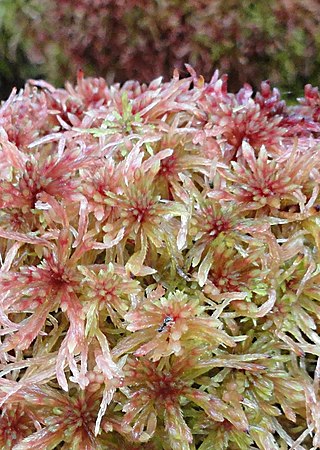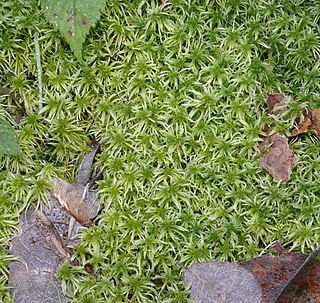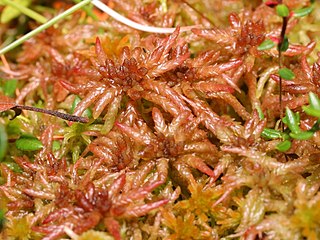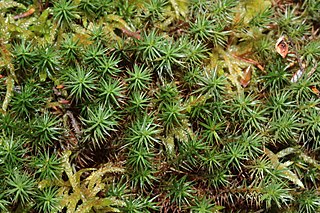
Sphagnum is a genus of approximately 380 accepted species of mosses, commonly known as sphagnum moss, also bog moss and quacker moss. Accumulations of Sphagnum can store water, since both living and dead plants can hold large quantities of water inside their cells; plants may hold 16 to 26 times as much water as their dry weight, depending on the species. The empty cells help retain water in drier conditions.

Burns Bog is an ombrotrophic peat bog located in Delta, British Columbia, Canada. It is the largest raised peat bog and the largest undeveloped urban land mass on the West Coast of the Americas. Burns Bog was originally 4,000–4,900 hectares before development. Currently, only 3,500 hectares remain of the bog.

Helodium blandowii, also known as Blandow's helodium moss, Blandow's tamarisk-moss, Blandow's bogmoss, and Blandow's feathermoss, is a rare plant in the Western U.S., including Oregon and California. It occurs all around the northern hemisphere in higher latitudes, and in some places is not as rare as in the Western U.S.

Aulacomnium palustre, the bog groove-moss or ribbed bog moss, is a moss that is nearly cosmopolitan in distribution. It occurs in North America, Hispaniola, Venezuela, Eurasia, and New Zealand. In North America, it occurs across southern arctic, subboreal, and boreal regions from Alaska and British Columbia to Greenland and Quebec. Documentation of ribbed bog moss's distribution in the contiguous United States is probably incomplete. It is reported sporadically south to Washington, Wyoming, Georgia, and Virginia.

Sphagnum angustifolium, the fine bogmoss, is a species of peat moss with a Holarctic distribution.

Sphagnum russowii, Russow's sphagnum or Russow's bogmoss, is a species of peat moss with a Holarctic distribution.

Sphagnum girgensohnii, also known as Girgensohn's bogmoss, Girgensohn's sphagnum or common green peat moss, is a species of peat moss with a Holarctic and Indo-Malesian distribution.

Sphagnum magellanicum, commonly called Magellanic bogmoss, Magellan's sphagnum, Magellan's peatmoss or midway peat moss, is a widespread species of moss found in wet boreal forest in the far south and southwest of South America, North America and Eurasia.

Sphagnum palustre, the prairie sphagnum or blunt-leaved bogmoss, is a species of peat moss from the genus Sphagnum, in the family Sphagnaceae. Like other mosses of this type it can soak up water up to the 30-fold amount of its own dry weight thanks to its elastic spiral fibers. S. palustre is rather frequent and is spread almost all over the world. It mainly grows in wet forests and—compared to other specimens of this genus—rarely grows in moors.

Sphagnum capillifolium, the red bogmoss, northern peat moss, acute-leaved bog-moss, or small red peat moss, is a species of peat moss native to Canada, the northern United States, Greenland, and Europe. Small red peat moss can be distinguished by its sweeping, outward-curving branches that resemble tresses. Sphagnum moss can hold large amounts of water within its cells, up to 20 times its own weight! This capability is due to its dead, empty cells called hyaline cells that fill up with water. This allows the moss to survive in wet boggy habitats around rivers and lakes

Sphagnum squarrosum, commonly known as the spiky bog-moss or spreading-leaved bog moss is a species of moss which grows in nutrient-rich, damp soil. Typical habitats include woodland, the banks of streams and ditches; it can even be found at high altitude in damp cirques. The species often grows near sedges (Carex), rushes (Juncus) or purple moor grass.

Sphagnum fallax, the flat-topped bogmoss, is a moss species in the genus Sphagnum

Sphagnum fuscum, the rusty bogmoss or rusty peat moss, is a peat moss found commonly in Norway and Sweden, and can be found scattered across North America, the United Kingdom, and in southern to eastern Europe.

Sphagnum cuspidatum, the feathery bogmoss, toothed sphagnum, or toothed peat moss, is a peat moss found commonly in Great Britain, Norway, Sweden, the eastern coast of the United States, and in Colombia.

Sphagnum fimbriatum, the fringed bogmoss, is a slender Sphagnum moss.

Polytrichum strictum, commonly known as bog haircap moss or strict haircap, is an evergreen and perennial species of moss native to Sphagnum bogs and other moist habitats in temperate climates. It has a circumboreal distribution, and is also found in South America and Antarctica.
William Robert Sherrin was a scientific collector, taxidermist, and amateur botanist. He was employed at the British Museum of Natural History from 1895 to 1947.

Sphagnum contortum is a species of moss reported in North America and Europe. NatureServe marked its global conservation status as Secure.
















